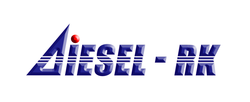Comparison of Hiroyasu combustion model and
RK-model
Main principles of RK-model are similar
with Hiroyasu combustion model, though there are considerable differences. The RK-model
provides more detailed modeling of:
- fuel sprays and walls interaction,
- interaction of wall surface flows formed by sprays among themselves.
Common properties:
Both models consist of two major portions: heat release model and
emission formation model.
The evolution of the spray is defined by empirical equations obtained
from experimental investigations. Two periods in spray evolution are taken into account.
The equations are different but similar.
It is assumed, that there are two main processes determine heat release
rate: rate of drops evaporation and rate of air entrainment into burning zone.
Effect of swirl on spray evolution is taken into account.
Both models use Sauter's mean diameter of drops.
Both models assume then the spray is divided into zones. Each zone has
own temperature, volume, mass of air and fuel..
Differences:
| Principle |
Hiroyasu model |
RK-model |
| Configuration of zones or packages |
There are lot of packages (zones): 250 or more. Configuration of each package is
defined by:
- current time,
- injection profile,
- package position in the initial spray,
- swirl intensity,
- distance to a wall. |
There are 10 characteristic zones.
Configuration of each zone is defined by:
- current time,
- injection profile,
- condition of evaporation,
- swirl intensity,
- piston bowl shape,
- piston-head clearance. |
| Parameters of zones. |
Mixing of fuel vapor with air and burned gas entrained in package is simulated.
Evaporation rate, heat release rate and current temperature are calculated in each
package. |
Characteristic temperature of zone is individual for each zone and used for
evaporation rate calculation in the zone. Heat release rate is calculated in the whole
cylinder as a function of sum of evaporation rates in the zones. |
| Strictly speaking we can not select regions in the spray where burning has
occur and where has not. In the spray there are huge number of burning pockets. |
System of equations
|
Uniform system of equations is used for all packages. |
Inside each zone own (similar) equations are used. |
| Interaction among zones. |
There is not mass exchange among packages. |
Fuel and air mass exchange among zones is taken into account. |
| Interaction among sprays. |
None. |
A special zone of wall surface flows crossing is taken into account. |
Bibliography
Hiroyuki Hiroyasu, Toshikazu Kadota and Masataka Arai: "Development and Use of a
Spray Combustion Modeling to Predict Diesel Engine Efficiency and Pollutant
Emissions," paper 214-12, Bull. JSME, vol. 26, No. 214, pp. 576-583, 1983.
To RK-model page










|



